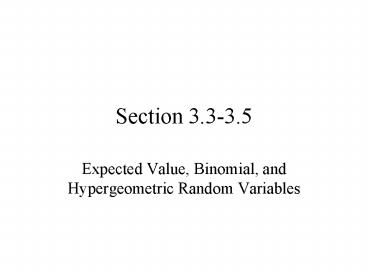Expected Value, Binomial, and Hypergeometric Random Variables PowerPoint PPT Presentation
1 / 16
Title: Expected Value, Binomial, and Hypergeometric Random Variables
1
Section 3.3-3.5
- Expected Value, Binomial, and Hypergeometric
Random Variables
2
Example 2. Poker hands.
Let X be the payoff earned with one poker hand.
What is the pmf of X? If you play the game many
times what average payoff would you expect? In
lab, compared to payoff of 10, 100 games.
3
The Expected Value of a Function
Let X be a discrete random variable with p.m.f.
p(x). The expected value or mean of X is given by
- If X is the payoff of a poker hand, what is E(X)?
- If X is the sum of two six sided die, what is
E(X)?
4
Example 3.
- Let X be the sum of two fair 6-sided dice. What
are the possible values of X2? What is the
probability of each of these outcomes? - Calculate E(X2).
- Expected value of a function. Let X be a
discrete r.v. with p.m.f. p(x) and let h(x) be a
function. Then
5
Mean, Variance and Standard Deviation
- Let X be a discrete random variable.
- We define the mean of X to be EX (usually
denoted ?). - We define the variance of X to be ?2 E(X ?
?)2 EX2 ? EX2.
(The first equality is taken as the definition of
variance. The last formula is used for
computations.) - We define the standard deviation of X to be ?
??2 . - These are theoretical versions of the sample
mean, sample variance and sample standard
deviation introduced for data.
6
Example 3. Continued.
Let X be the sum of two fair six sided die.
Recall E(X). and E(X2). Calculate the variance
from the definition. Calculate the variance from
the shortcut formula. What is the standard
deviation? In Minitab, generate 100 realizations
of X. Calculate the mean and standard deviation
of the data.
7
Summary of 3.3
- Use the p.m.f. to calculate expected value of a
random variable. - Calculate expected value of a function of a
random variable. - Mean, Variance, and Standard Deviation of a
random variable (m, s2, s). - Mean, variance, standard deviation of a data set
(x_bar, s2, s)
8
Binomial Random Variables
- Recall what binomial models.
- Think of an application of the binomial r.v.
- What is the pmf of a binomial r.v.? Note instead
of p(x), pmf is labeled b(xn,p).
9
CDF of Binomial R.V.
- Instead of F(x), cdf is labeled B(xn,p). The
cdf is tabulated in A.1. Part given here. - Suppose X is Bin(n,p),
- find P(X?2) from pmf.
- find P(X?2) from cdf.
- Find P(2 ?X ?5) from pmf.
- Find P(2 ?X ?5) from cdf.
10
Mean and Variance of Binomial
- Give summations necessary for finding mean and
variance of a random variable. - Summations simplify to
- The mean of a binomial is np.
- The variance is np(1-p).
11
Hypergeometric Random Variables
- Recall what hypergeometric probabilities are used
for. Think of an application of hypergeometric
probabilities. - Let X be the number of successes obtained when
sampling from a population of size N with M
successes and N-M failures. X is a hypergeometric
r.v. What is the pmf of X? Note instead of p(x),
pmf is labeled h(xn,M,N).
12
Mean and Variance
- The mean of a hypergeometric r.v. is
- The variance is np(1-p).
13
Relationship between binomial and hypergeometric.
- One application of binomial is sampling from
finite population of S and F with replacement. - While the hypergeometric is sampling w/o
replacement.
14
Recall HW problem
- 10000 boards, 2000 of which are green. Sample 2
boards . Are the events 1st board is green and
second board is green independent if sampling
is done - w/ replacement
- w/o replacement
- Suppose instead there are only 10 boards, 2 of
which are green and the sampling is done
w/replacement. - W/o replacement
15
Compare mean and variance.
- Set pM/N. Sample size of n.
- What is the expected number of successes if
sampling is done with replacement? Without
replacement? - What is the variance of the number of successes
if sampling is done with replacement? Without
replacement?
16
Notes
- You should know and/or be able to derive pmfs of
Binomial and Hypergeometric random variables. - You should know mean and variance of each.
- You should be able to use tabulated cdf for
Binomial random variables. - You are not responsible for the negative binomial
r.v. described in section 3.5 or the Poisson r.v
described in section 3.6. However, you should be
able to work with these and potentially other
random variables if details are given.

